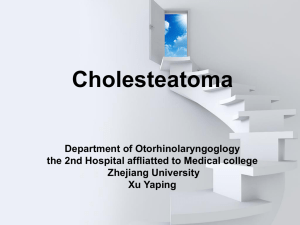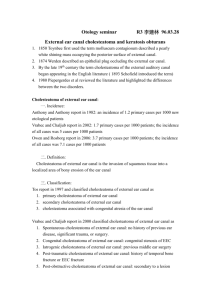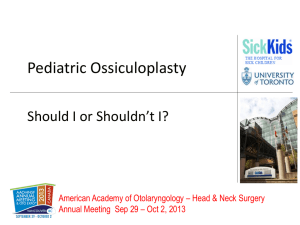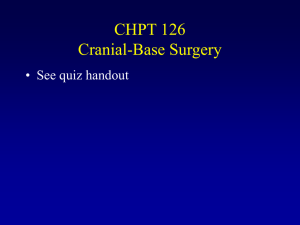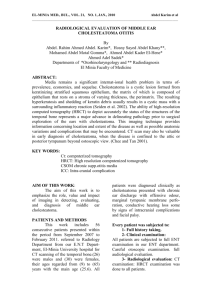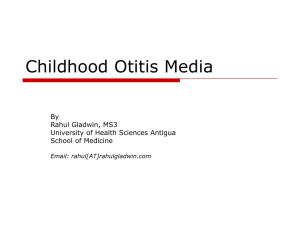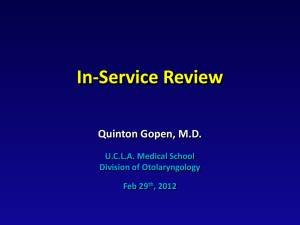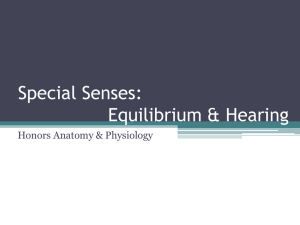Cholesteatoma Easily Missed? Cholesteatoma Mahmood F Bhutta
advertisement
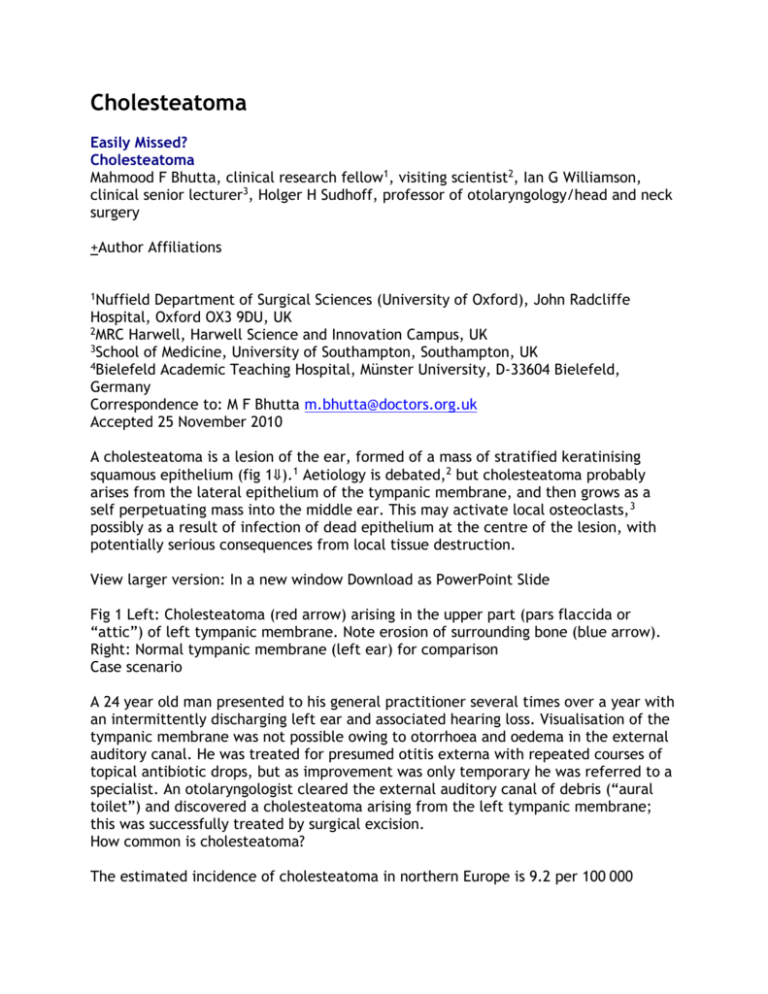
Cholesteatoma Easily Missed? Cholesteatoma Mahmood F Bhutta, clinical research fellow1, visiting scientist2, Ian G Williamson, clinical senior lecturer3, Holger H Sudhoff, professor of otolaryngology/head and neck surgery +Author Affiliations 1Nuffield Department of Surgical Sciences (University of Oxford), John Radcliffe Hospital, Oxford OX3 9DU, UK 2MRC Harwell, Harwell Science and Innovation Campus, UK 3School of Medicine, University of Southampton, Southampton, UK 4Bielefeld Academic Teaching Hospital, Münster University, D-33604 Bielefeld, Germany Correspondence to: M F Bhutta m.bhutta@doctors.org.uk Accepted 25 November 2010 A cholesteatoma is a lesion of the ear, formed of a mass of stratified keratinising squamous epithelium (fig 1⇓).1 Aetiology is debated,2 but cholesteatoma probably arises from the lateral epithelium of the tympanic membrane, and then grows as a self perpetuating mass into the middle ear. This may activate local osteoclasts, 3 possibly as a result of infection of dead epithelium at the centre of the lesion, with potentially serious consequences from local tissue destruction. View larger version: In a new window Download as PowerPoint Slide Fig 1 Left: Cholesteatoma (red arrow) arising in the upper part (pars flaccida or “attic”) of left tympanic membrane. Note erosion of surrounding bone (blue arrow). Right: Normal tympanic membrane (left ear) for comparison Case scenario A 24 year old man presented to his general practitioner several times over a year with an intermittently discharging left ear and associated hearing loss. Visualisation of the tympanic membrane was not possible owing to otorrhoea and oedema in the external auditory canal. He was treated for presumed otitis externa with repeated courses of topical antibiotic drops, but as improvement was only temporary he was referred to a specialist. An otolaryngologist cleared the external auditory canal of debris (“aural toilet”) and discovered a cholesteatoma arising from the left tympanic membrane; this was successfully treated by surgical excision. How common is cholesteatoma? The estimated incidence of cholesteatoma in northern Europe is 9.2 per 100 000 population a year4 Therefore a general practitioner with a practice size of 2500 patients would be expected to see on average one new case every four to five years The peak incidence is in the age range 5-15 years,5 but cholesteatoma can arise in any age group Seven per cent of people diagnosed will subsequently develop cholesteatoma in the contralateral ear5 The incidence is reportedly higher in white than non-white populations. Why is cholesteatoma missed? The onset of disease may be insidious with intermittent or mild symptoms. Typically cholesteatoma presents with intermittent unilateral otorrhoea (ear discharge) and a progressive hearing loss,6 which may mimic and be misdiagnosed as recurrent or chronic otitis externa or otitis media. Successful negligence claims have been filed in the United Kingdom (http://boyesturnerclaims.com/case-study.html?id=85) and the United States (www.upton-hatfield.com/news/verdicts.html) for complications resulting from a missed diagnosis in primary care, although no published data are available on frequency of misdiagnosis. Why does it matter? A cholesteatoma is a self perpetuating mass, which if untreated, can cause extensive local tissue destruction. At presentation the ossicles are often eroded, contributing to conductive hearing loss.7 Rarely cholesteatoma may erode into the inner ear causing sensorineural hearing loss or vertigo, or lead to facial palsy from damage to the facial nerve as it traverses the middle ear.8 Cholesteatoma can also lead to spread of infection through the tegmen (roof) of the middle ear causing meningitis or intracranial abscess (fig 2⇓), a risk estimated to be 1 in 10 000 a year of untreated disease.9 View larger version: In a new window Download as PowerPoint Slide Fig 2 Sagittal computed tomogram through the temporal bones of a patient with longstanding left cholesteatoma. The bony tegmen (roof) of the left middle ear has eroded (arrow), leading to an abscess in the temporal lobe How is cholesteatoma diagnosed? Clinical features Symptoms of cholesteatoma—such as persistent hearing loss (present in 83% of 23 ears in a case series), otorrhoea (56%), otalgia (39%), vertigo, or tinnitus—are nonspecific,6 and so the diagnosis rests on the appearance on otoscopic examination. Cholesteatoma is classically described as “wax in the attic”: a yellow or white crust visible in the upper part (pars flaccida or “attic”) of the tympanic membrane, often surrounded by pus, and with a perforation of the adjacent tympanic membrane and erosion of the surrounding bone (fig 1⇑). In advanced cases, bony erosion may be severe and normal anatomy difficult to recognise. Whereas most cholesteatomas arise in the attic, they can also arise in the lower part (pars tensa) of the tympanic membrane.7 In primary care, cholesteatoma should be suspected in an ear with recurrent or persistent otorrhoea that fails to settle fully with treatment. In general practice such symptoms are more often the result of recurrent otitis externa or recurrent otitis media,10 but only a full visualisation of the tympanic membrane allows cholesteatoma to be excluded. In all new cases of facial palsy otoscopy should be used to exclude cholesteatoma as a cause.11 Visualisation, however, may be difficult. When a cholesteatoma is temporarily or permanently active, the external auditory canal may become filled with purulent discharge and be oedematous, and if facilities are not available for aural toilet, obtaining an adequate view of the tympanic membrane may be impossible. Chronic inflammation may also cause the formation of a macroscopic polyp of granulation tissue,12 which again can obstruct the view. In paediatric cases the child may not permit examination. In difficult cases it is worth treating the ear for a presumed infection and bringing the patient back for re-examination of the ear once infection has settled. When visualisation is still difficult and symptoms continue, refer the patient to an otolaryngologist for aural toilet or application of topical steroid creams to granulation tissue (possibly under general anaesthesia for a child); this will allow the tympanic membrane to be seen and the presence or absence of cholesteatoma verified. Investigations High resolution computed tomography can help to define the likely extent of a cholesteatoma, and it may show bony erosion, which makes the diagnosis more likely.13 It may also show complications from more advanced disease. Diffusion weighted magnetic resonance imaging has also been used to show cholesteatoma.14 However, no imaging is sufficiently sensitive or specific for cholesteatoma, 15 and the cornerstone of diagnosis remains clinical, based on the appearance on otoscopy. An audiogram is needed to define the degree and type of hearing loss. Typically a conductive hearing loss is found, as a result of the cholesteatoma mass itself or erosion of ossicles, but an additional sensorineural hearing loss may be present if the cochlea has also sustained damage. How is it managed? When cholesteatoma is diagnosed or suspected, “semi-urgent” referral (for the patient to be seen by a specialist within a few weeks) is appropriate. However, if facial palsy is also present, refer immediately, because if the palsy is caused by the cholesteatoma, delayed treatment is associated with a worse prognosis. 16 17 18 The presence of pain or other neurological symptoms or signs should also prompt urgent referral as these may portend intracranial complications. Surgical excision is the only known cure for cholesteatoma, and the choice of operation depends on the extent of the lesion. Local excision may be sufficient for early cholesteatoma, but more extensive disease requires exploration of the mastoid air cells with a mastoidectomy. This sometimes means that the mastoid air cells are “externalised” by surgical excision of the posterior external auditory canal, to form a mastoid cavity. The risk of residual disease after surgery varies (5% to 30%) with the procedure and extent of the disease, and patients require follow-up and sometimes repeat exploratory surgery. In some older patients and in patients with concurrent morbidity, conservative management of cholesteatoma may be an option, but as highlighted above, this carries a small but continuing risk of serious complications from this disease. Key points Cholesteatoma is a locally destructive lesion of the middle ear, in the form of a cyst of keratinous epithelium Cholesteatoma can occasionally lead to serious consequences, including facial palsy, meningitis, or brain abscess It should be suspected in any case of persistent or recurrent ear discharge The key to diagnosis is a characteristic appearance on otoscopy Notes Cite this as: BMJ 2011;342:d1088 Footnotes This is one of a series of occasional articles highlighting conditions that may be more common than many doctors realise or may be missed at first presentation. The series advisers are Anthony Harnden, university lecturer in general practice, Department of Primary Health Care, University of Oxford, and Richard Lehman, general practitioner, Banbury. To suggest a topic for this series, please email us at easilymissed@bmj.com. Thanks to David Pothier for providing the images in figure 1. Contributors: MFB conceptualised the article and researched and wrote the first draft. IGW and HHS made important revisions. Funding: No additional funding. Competing interests: All authors have completed the Unified Competing Interest form at www.icmje.org/coi_disclosure.pdf (available on request from the corresponding author) and declare: no support from any company for the submitted work; IGW has previously received an honorarium from GlaxoSmithKline for a symposium on prescribing in otitis media; and no non-financial interests that may be relevant to the submitted work. Provenance and peer review: Not commissioned; externally peer reviewed. Patient consent not required (patient anonymised, dead, or hypothetical). References 1 Browning GG, Merchant SM, Kelly G, Swan IRC, Canter R, McKerrow WS. Chronic otitis media. In: Gleeson MJ, ed. Scott-Brown’s otorhinolaryngology, head and neck surgery. 7th ed. Hodder Arnold, 2008:3395-445. 2 Olszewska E, Wagner M, Bernal-Sprekelsen M, Ebmeyer J, Dazert S, Hildmann H, et al. Etiopathogenesis of cholesteatoma. Eur Arch Otorhinolaryngol2004;261(1):6-24. [CrossRef][Medline] 3 Jung JY, Chole RA. Bone resorption in chronic otitis media: the role of the osteoclast. ORL J Otorhinolaryngol Relat Spec2002;64:95-107. [Medline] 4 Kemppainen HO, Puhakka HJ, Laippala PJ, Sipila MM, Manninen MP, Karma PH. Epidemiology and aetiology of middle ear cholesteatoma. Acta Otolaryngol 1999;119:568-72. [CrossRef][Medline] 5 Rosenfeld RM, Moura RL, Bluestone CD. Predictors of residual-recurrent cholesteatoma in children. Arch Otolaryngol Head Neck Surg1992;118:384-91. [Abstract/FREE Full text] 6 Sheahan P, Donnelly M, Kane R. Clinical features of newly presenting cases of chronic otitis media. J Laryngol Otol2001;115:962-6. [Medline][Web of Science] 7 Wetmore RF, Konkle DF, Potsic WP, Handler SD. Cholesteatoma in the pediatric patient. Int J Pediatr Otorhinolaryngol1987;14:101-12.[CrossRef] [Medline][Web of Science] 8 Smith JA, Danner CJ. Complications of chronic otitis media and cholesteatoma. Otolaryngol Clin North Am2006;39:1237-55.[CrossRef][Medline] [Web of Science] 9 Nunez DA, Browning GG. Risks of developing an otogenic intracranial abscess. J Laryngol Otol1990;104:468-72. [Medline][Web of Science] 10 Bain J, Williamson I. Treating the discharging ear in general practice. BMJ1988;296:1617. [FREE Full text] 11 Syed I, Bhutta M. Facial nerve palsy: assessment and management. Br J Hosp Med (Lond)2008;69(3):M34-7. [Medline] 12 Milroy CM, Slack RW, Maw AR, Bradfield JW. Aural polyps as predictors of underlying cholesteatoma. J Clin Pathol1989;42:460-5. [Abstract/FREE Full text] 13 Lemmerling MM, de Foer B, VandeVyver V, Vercruysse JP, Verstraete KL. Imaging of the opacified middle ear. Eur J Radiol2008;66:363-71. [CrossRef][Medline][Web of Science] 14 Vercruysse JP, de Foer B, Somers T, Casselman J, Offeciers E. Magnetic resonance imaging of cholesteatoma: an update. B-ENT2009;5:233-40. [Medline] 15 O’Reilly BJ, Chevretton EB, Wylie I, Thakkar C, Butler P, Sathanathan N, et al. 16 17 18 The value of CT scanning in chronic suppurative otitis media. J Laryngol Otol1991;105:990- 4. [Medline][Web of Science] Omran A, De Denato G, Piccirillo E, Leone O, Sanna M. Petrous bone cholesteatoma: management and outcomes. Laryngoscope2006;116:619-26. [CrossRef][Medline][Web of Science] Ikeda M, Nakazato H, Onoda K, Hirai R, Kida A. Facial nerve paralysis caused by middle ear cholesteatoma and effects of surgical intervention. Acta Otolaryngol 2006;126:95-100. [CrossRef][Medline] Siddiq MA, Hanu-Cernat LM, Irving RM. Facial palsy secondary to cholesteatoma: analysis of outcome following surgery. J Laryngol Otol2007;121:114-7. [Medline][Web of Science]
